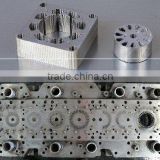Manufacturing Rotor and Stator lamination in the Stamping Die
USD $0.89 - $1.98 /Set
Min.Order:5000 Sets
Quick Details View All >
Shenzhen Jiarun Precision Mould Co., Ltd.
Product Details
Design strategy
Design strategy based on mechanistic understanding of how
materials & process interactions affect product performance
Product quality & performance ensured by design & operation
of effective & efficient processes
Flawless execution:
Accelerate time to market
Less trial and error
Improve efficiency
Successful companies deliver
innovative products first and
profitably
Producing finished stacks of rotor and stator laminations in the die has many advantages to the manufacturers of electric motors, particularly the elimination of downstream manual or mechanical assembly operations such as riveting or welding. Staking in the die also can produce stacks of more uniform height.
A die capable of staking laminations together requires a specially designed die cavity and special staking punches. The staking punches create protrusions that cause the individual laminations to stick together as they become a stack in the die cavity. Whether as many as four or more staking punches should be used depends on the size and design of the rotoror stator part.
Rotation is not necessarily confined to rotors. If a stator is perfectly symmetrical, it also may be rotated in a staking die cavity. In addition, when motor manufacturers require loose rotor laminations, the laminations may be rotated without being staked together and loaded into stacking chutes. When these loose laminations finally are assembled, they will also exhibit improved perpendicularity and balance.
Many motor designs incorporate a skew angle in the rotor assembly to improve motor performance. In Oberg-produced dies that contain the rotating skewing cavity, the skew angle to the rotor stack is quickly set by entering the desired skew angle into the control system. Skew angles may be set in addition to the rotation or by themselves without any other rotation in the lamination.
The Rotor is the rotating part of the generator. As it rotates within the stator, a vortex is created, which sucks the product to be processed into the generator or working zone. In this process, the product is accelerated axially and pushed to the outside through the tooth apertures of the stator by centrifugal force. The Rotor is the rotating part of the generator. As it rotates within the stator, a vortex is created, which sucks the product to be processed into the generator or working zone. In this process, the product is accelerated axially and pushed to the outside through the tooth apertures of the stator by centrifugal force.
Contact Supplier

You May Like
New Products
Popular Searches
Recommended Products
Find Similar Products By Category